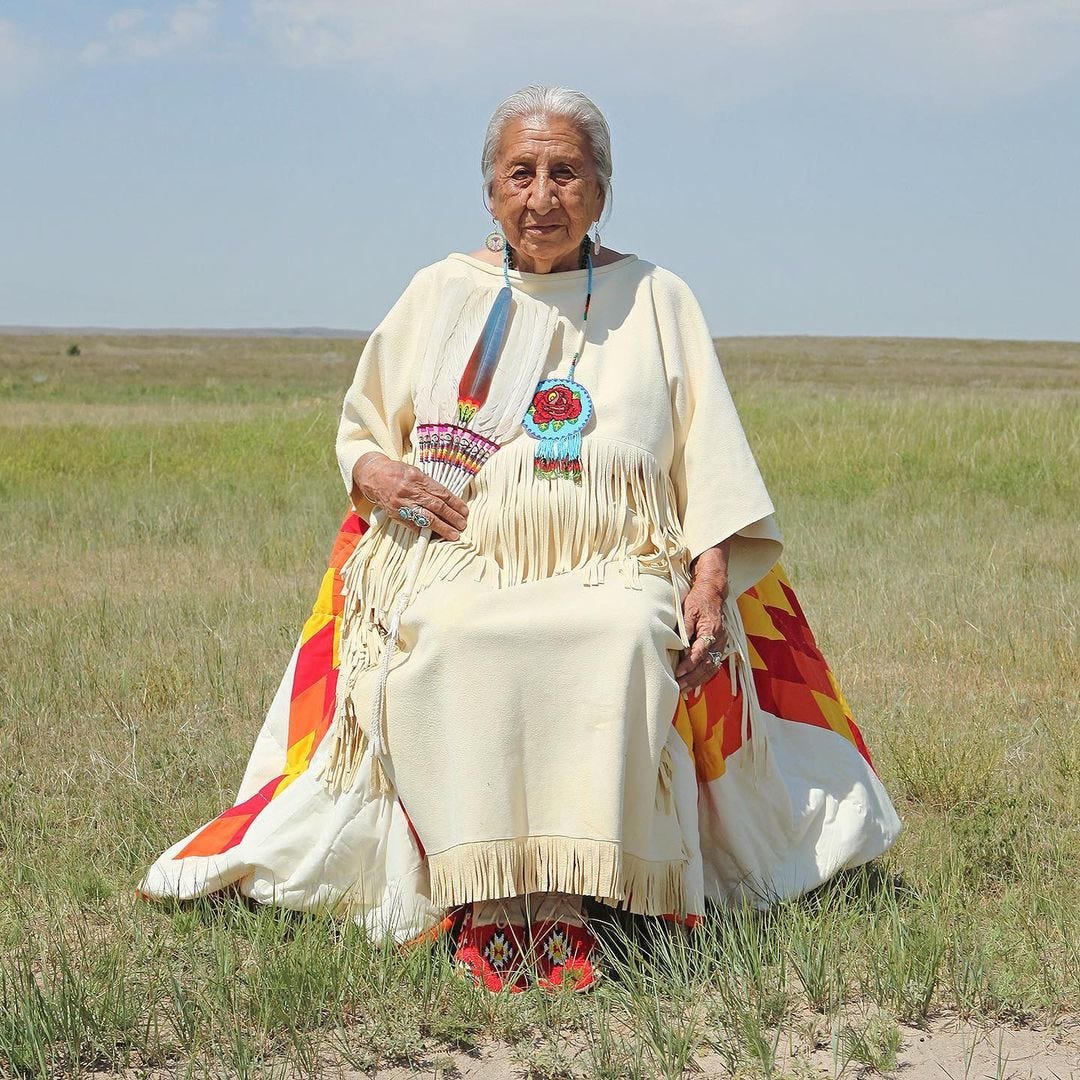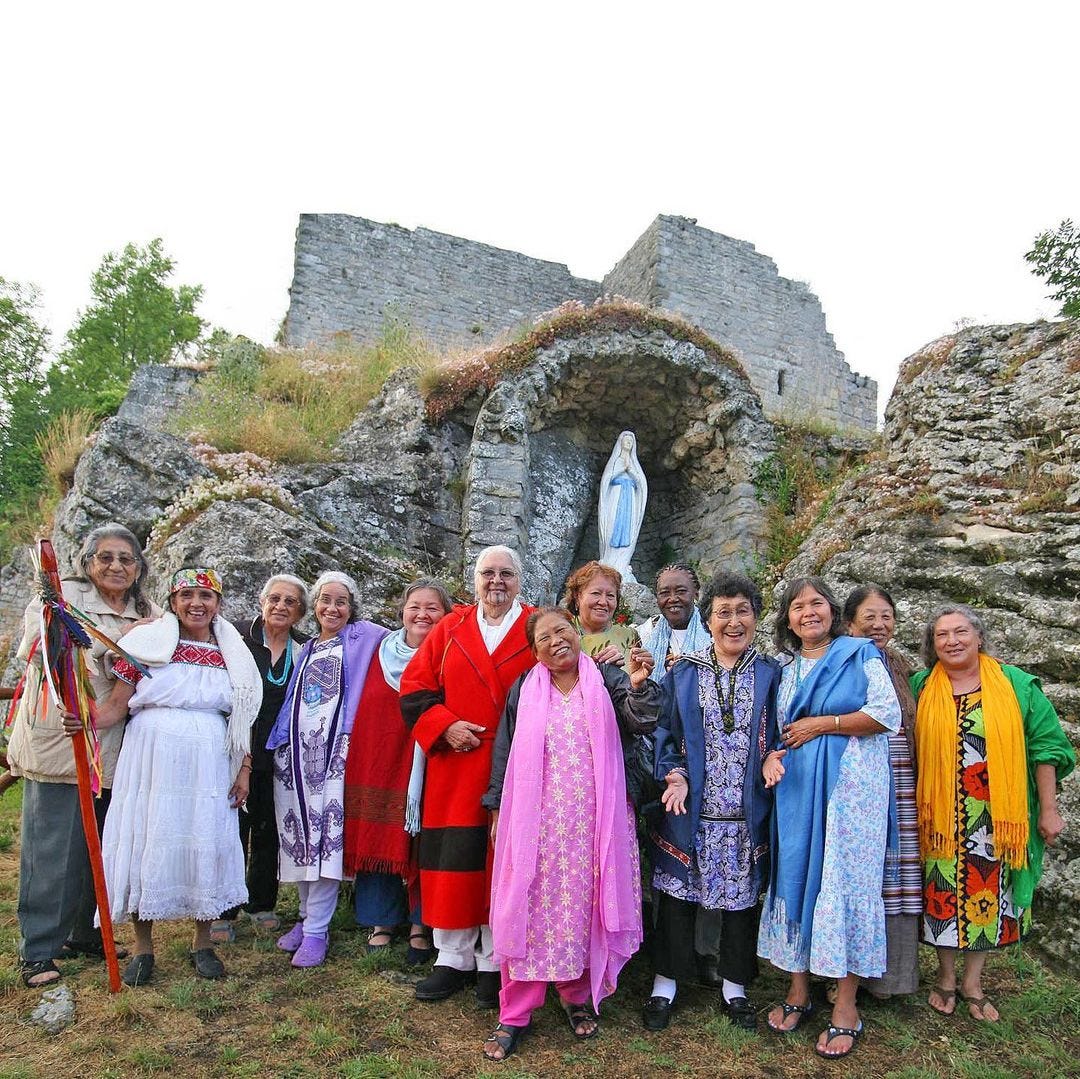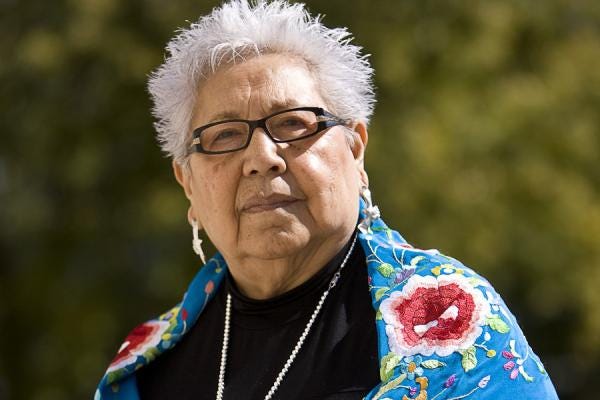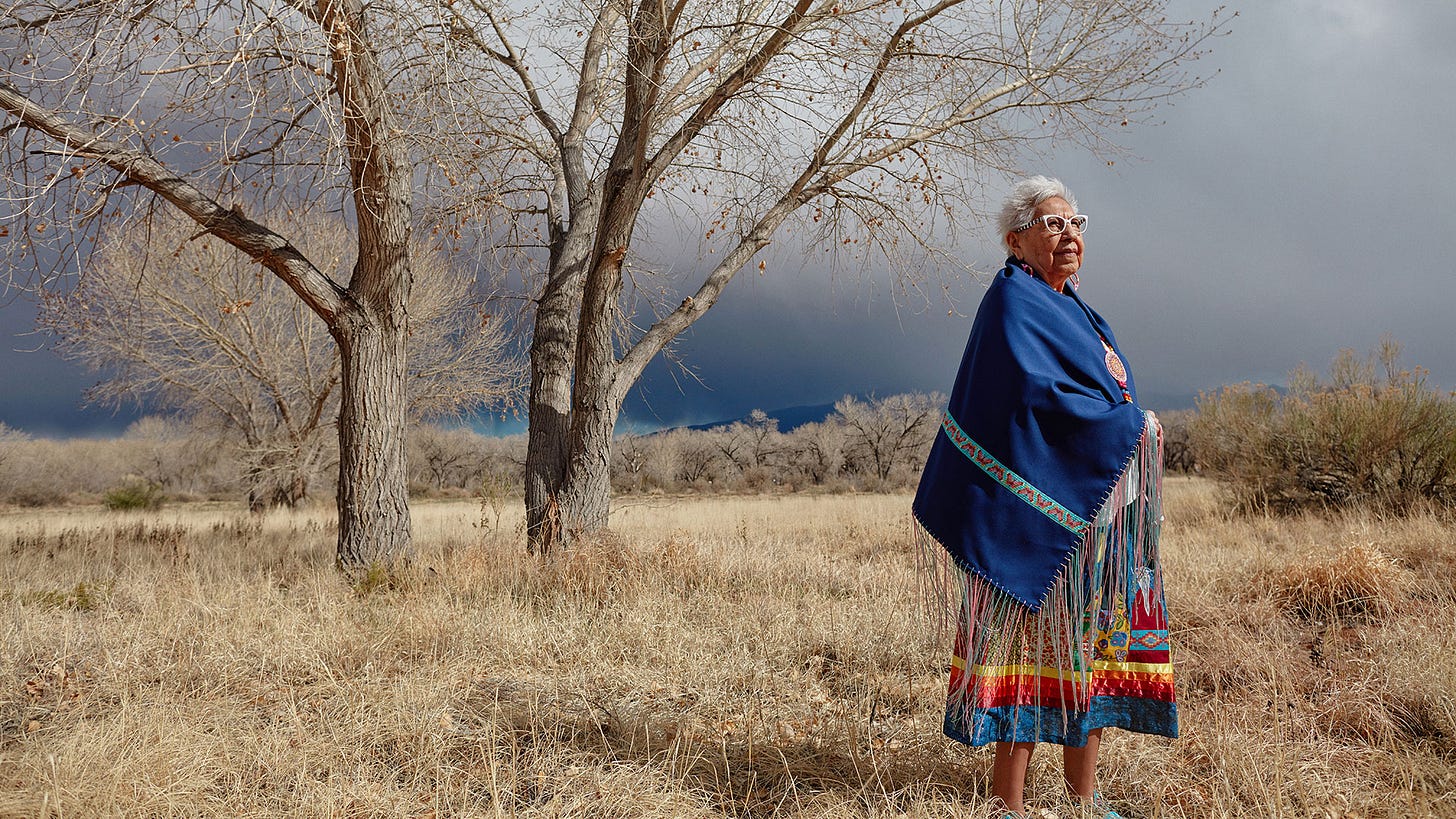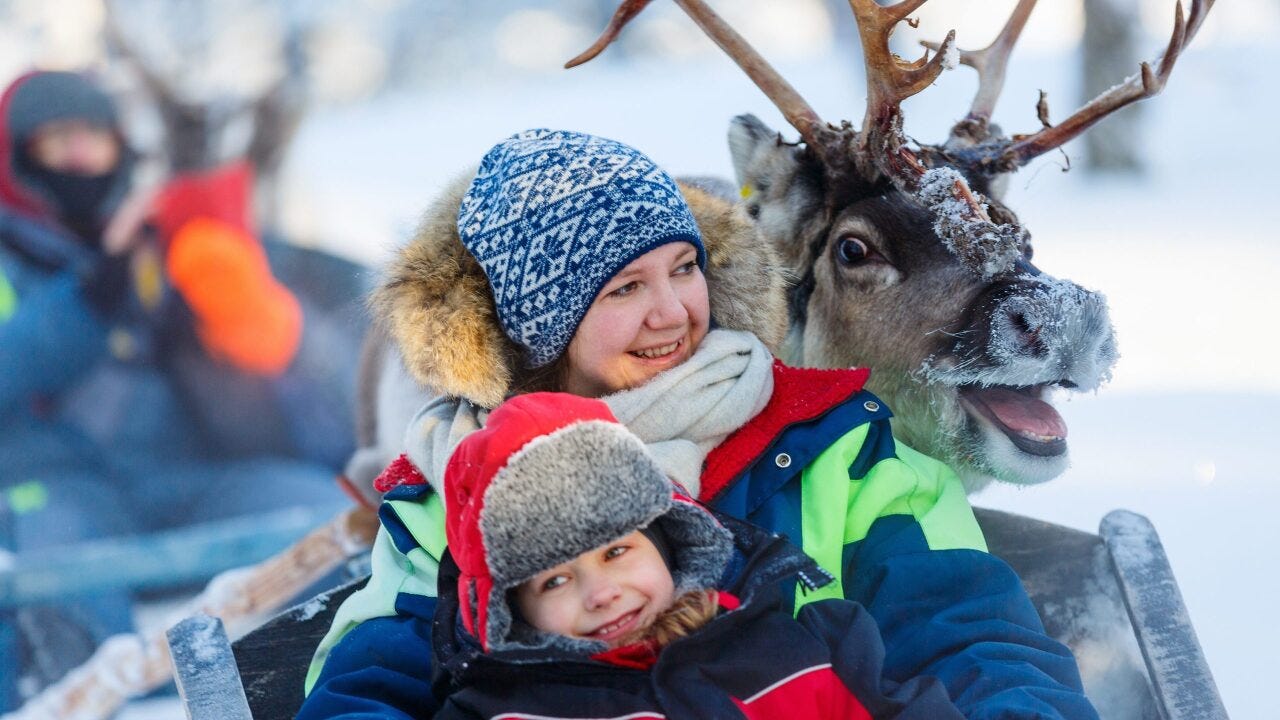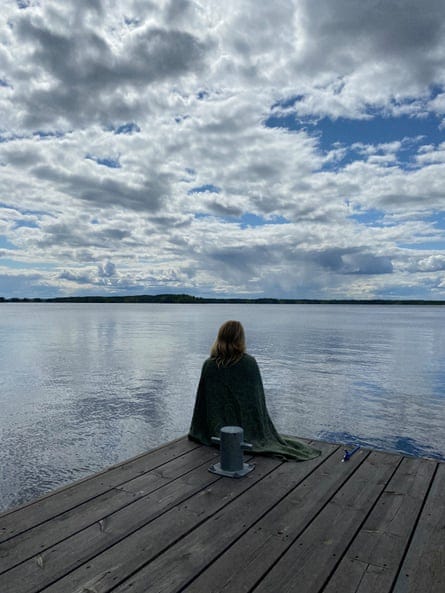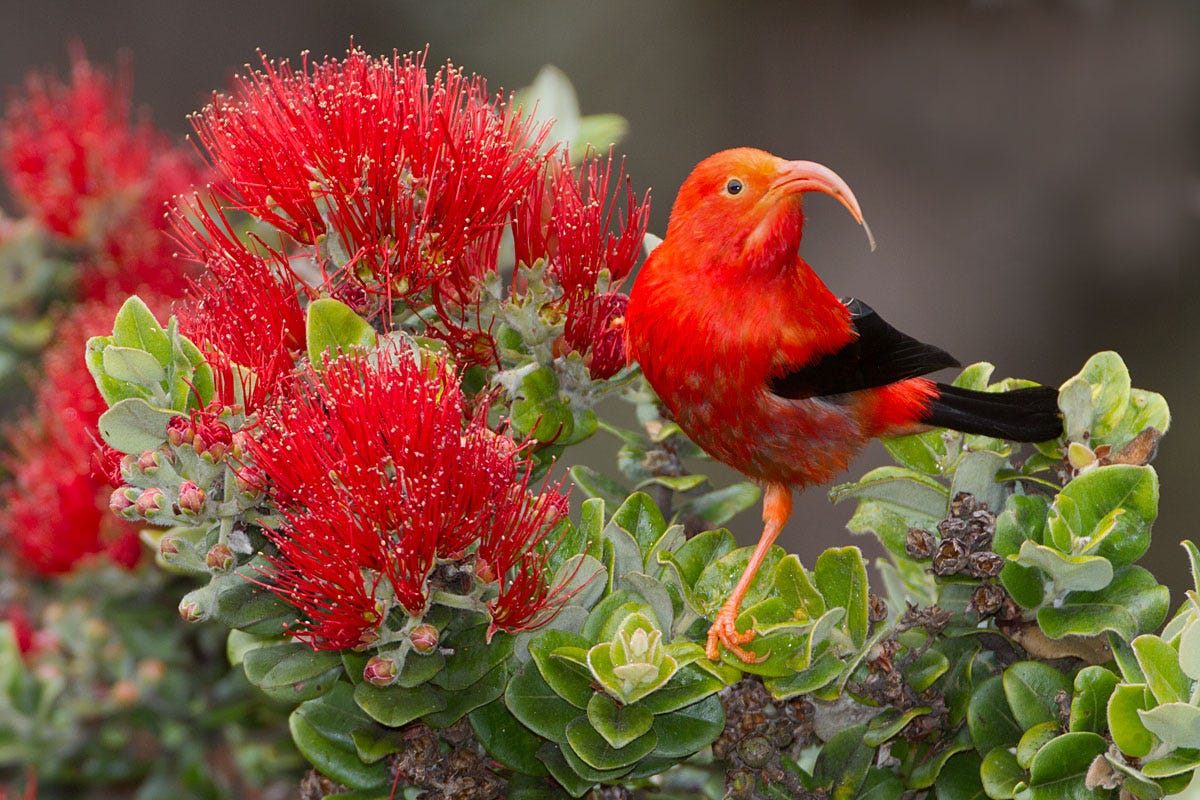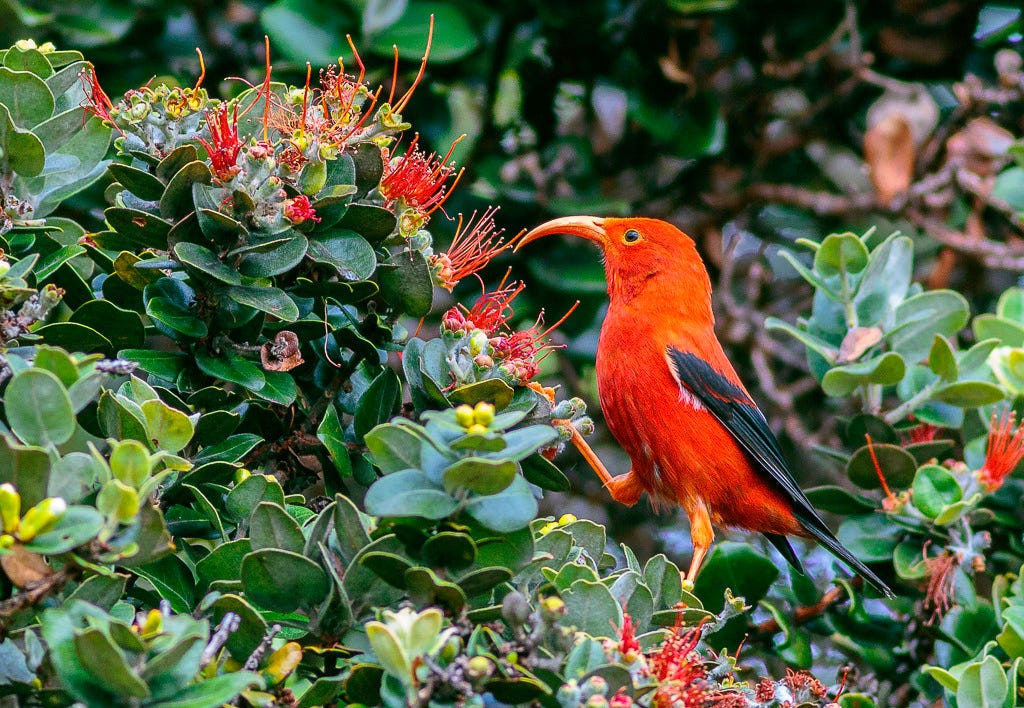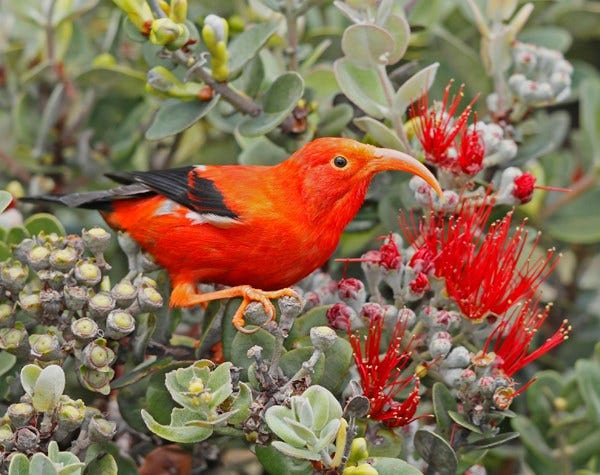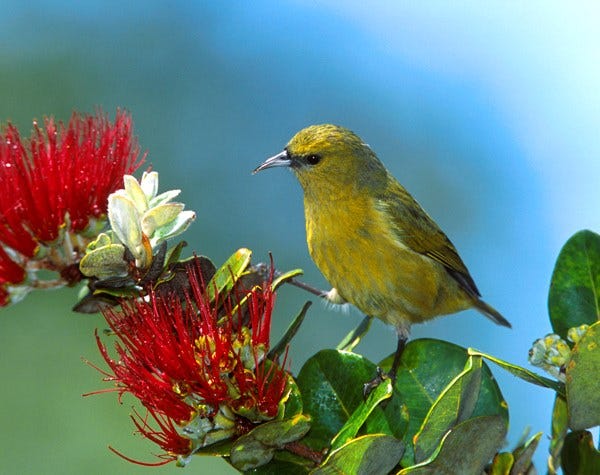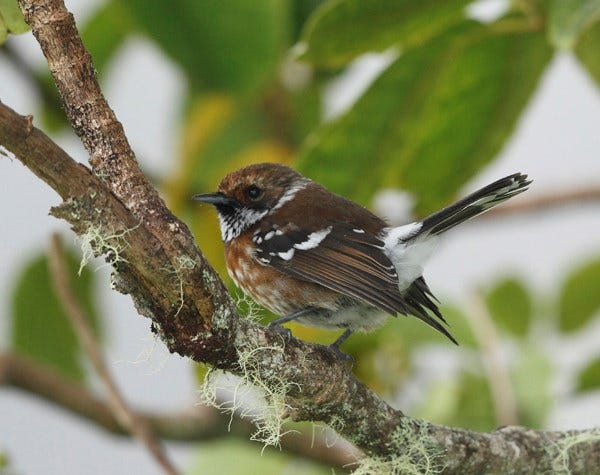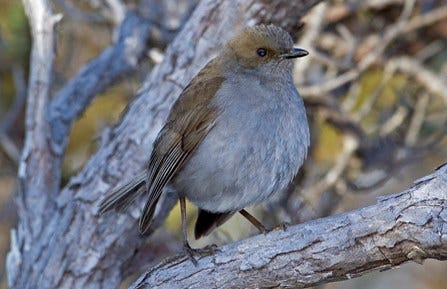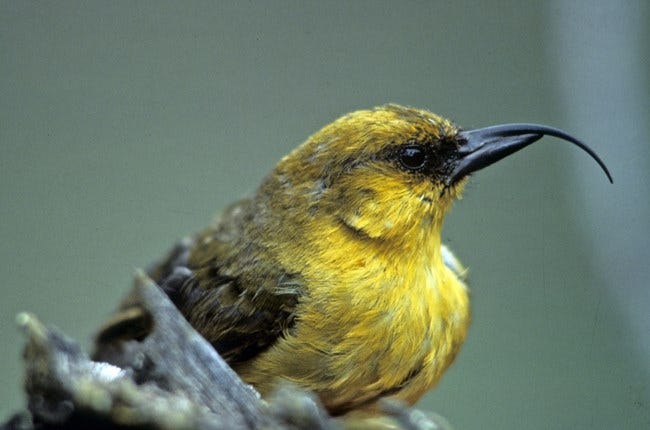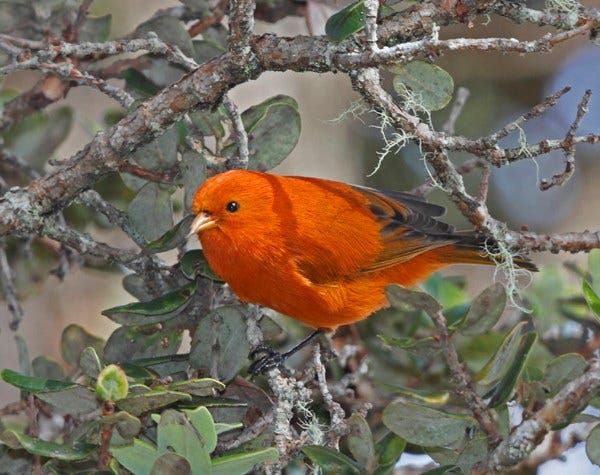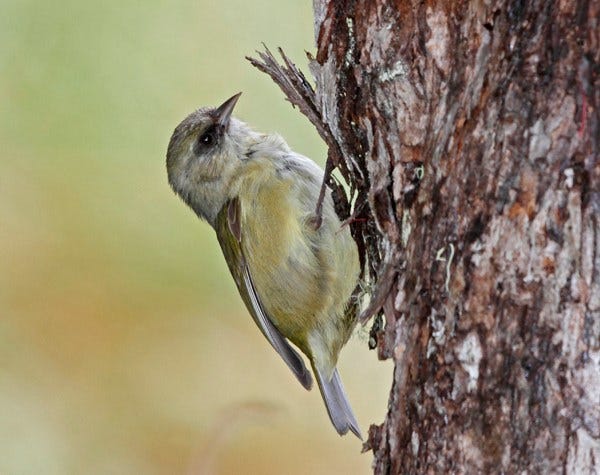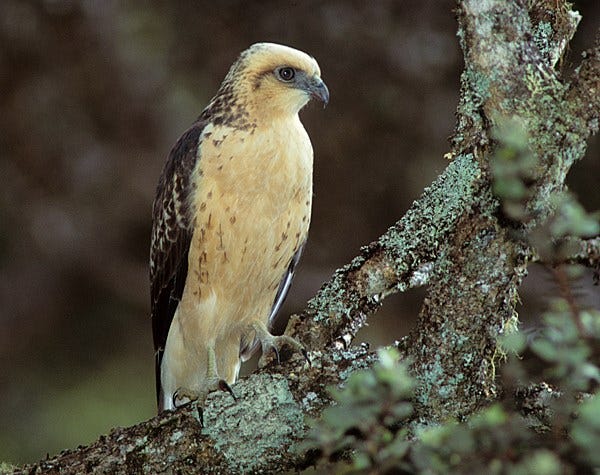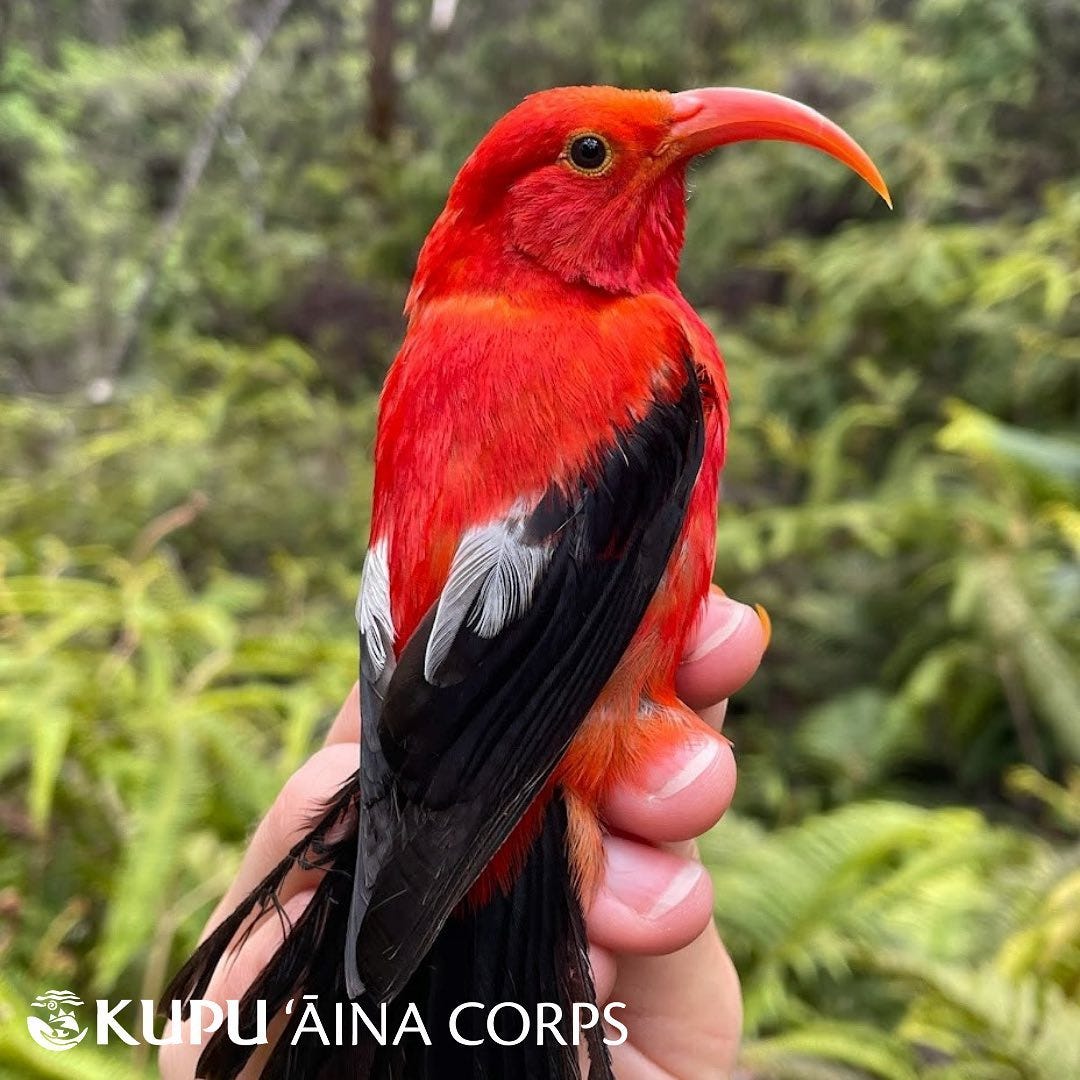Message from Council of 13 Grandmothers💜❤️🌟💙💚
Lessons in happiness & saving Hawaiian endangered birds 🌋 ❥ 🐦
Message from the Council of 13 Indigenous Grandmothers:
"As you move through these changing times... be easy on yourself and be easy on one another. You are at the beginning of something new. You are learning a new way of being.
Instead of traveling to a goal out there, you will voyage deeper into yourself. Your mother's grandmother knew how to do this. Your ancestors from long ago knew how to do this. They knew the power of the feminine principle... and because you carry their DNA in your body, this wisdom and this way of being is within you.
Call on it. Call it up. Invite your ancestors in. As the yang based habits and the decaying institutions on our planet begin to crumble, look up. A breeze is stirring. Feel the sun on your wings."
“We (the Grandmothers), like all humans, have carried deep wounds, individually and collectively. Nevertheless, there is something that we did that distinguishes our walk on Earth. Instead of placing ourselves in the comfortable position of accusing someone else, to make them responsible for our suffering, we took responsibility for our wounds and decided to transform them into beauty by cultivating compassion and by constructing freedom. That is what we did. And it was only possible because we joined our efforts and our prayers.
Take responsibility — that is an important legacy of the Thirteen Grandmothers.”
“Have courage, for without it we have no justice, without justice we have no freedom, and without freedom we have no peace.”
~Grandmother Beatrice Long Visitor Holy Dance
https://www.grandmotherswisdom.org/
Congratulations to our dear grandmother Dr. Henrietta Mann on receiving the National Humanities Award! ✨🙌✨
Renowned Cheyenne educator and elder Henrietta Mann has been awarded a National Humanities Medal, one of the highest honors the U.S. bestows on academics.
The medal goes to scholars and others whose work is deemed to have a lasting cultural impact. President Joe Biden credited Mann for her pivotal role in establishing Native American studies as an academic field in higher education.
Mann’s White House Citation read:
WHITE HOUSE CITATION
Henrietta Mann, for dedicating her life to strengthening and developing Native American education. The pioneering efforts of Henrietta, Ho’oesto’oona'e, Mann, led to programs and institutions across the country devoted to the study of Native American history and culture, honoring ancestors that came before and benefiting generations that follow.
Henrietta Mann is a full-blood Cheyenne, an elder of her people, and a citizen of the Cheyenne-Arapaho Tribes of Oklahoma. She is a celebrated educator, a professor of Native American studies, and a leading figure in the development of programs devoted to Native American studies. “Henri,” as she is known to her friends, is something else as well. She is the kind of person who when she speaks—slowly, directly, and with mounting force, calling on her long memory as a person and a Cheyenne—stops you in your tracks and makes you listen very closely.
Mann hopes the national recognition for her work signals a turning point in higher education, where Indigenous viewpoints will be incorporated across all areas of study and drawn on to address issues such as climate change and global warming.
“Our teachings say we have to live as respectful relatives in an ocean of relationships in which all life exists,” she said. “We’re not isolated. We’re not above all the other peoples. We just are, and we need to be respectful of this beautiful world in which we are placed.”
“I teach them with the hope and the dreams that they, too, will teach those that have yet to come to walk on this earth,” she said.
https://www.neh.gov/award/henrietta-mann
https://linktr.ee/grandmotherswisdom
Nunavik Inuktitut
ᐃᓅᔪᓕᒫᑦ ᐊᓂᖅᑎᕆᔪᓕᒫᑦ ᐃᓅᓚᐅᕐᒪᑕ ᐃᓱᒪᕐᓱᕐᖢᑎᒃ ᐊᒻᒪᓗ ᐊᔾᔨᐅᖃᑎᒌᒃᖢᑎᒃ ᓂᕐᓱᐊᖑᓂᒃᑯᑦ
ᐊᒻᒪᓗ ᐱᔪᓐᓇᐅᑎᑎᒍᑦ. ᐃᓱᖃᖅᑐᖁᑎᖃᕐᑎᑕᐅᕙᓕᕐᐳᑦ ᐱᔾᔪᑎᖃᕐᓂᒃᑯᑦ ᐊᒻᒪᓗ ᐃᓱᒪᒋᓯᒪᓂᒃᑯᑦ ᖃᓄᐃᓕᔾᔪᑎᖃᕆᐊᖃᓕᕐᑐᑦ
ᐃᒻᒥᖕᓅᖃᑎᒌᒡᓗᑎᒃ ᐅᒃᐱᕐᓂᒃᑯᑦ ᖃᑕᙳᑎᒌᑦᑎᐊᕆᐊᖃᕐᓂᒃᑯᓪᓗ. (ᐃᓚᖓ 1 ᓯᓚᕐᔪᐊᕐᒥᐅᑦ ᓇᓗᓇᐃᖅᓯᐅᑎᖓ ᑭᓇᒃᑯᑐᐃᓐᓇᐃᑦ ᐱᔪᓐᓇᐅᑎᖏᑦ)
Translation
All human beings are born free and equal in dignity and rights. They are endowed with reason and conscience and should act towards one another in a spirit of brotherhood.
(Article 1 of the Universal Declaration of #HumanRights)
🌎 🌞 🌱 🌳 🐝 🍑 🍈 🍐 🌳 🌴 🌲
We are in Crisis
I looked for happiness in Finland – and learned “happiness is a place between too little and too much”.
Yes, Finland has nature and saunas in abundance. But more important is an attitude I’ve found lacking in the UK
When I was invited to take part in a masterclass in happiness on the shores of Finnish Lakeland, a few of my friends expressed their surprise. But, Lucy, said one, you’re one of the happiest people I know. What are you hoping to learn from the Finns? I suppose she had a point. I’ve always been one of those annoying, glass-half-full people – not the most obvious choice for a four-day trip designed to teach me why Finnish people are consistently rated the happiest in the world. But, ever the optimist, I gladly accepted.
We Britons have about 60 words for happiness: blissfulness, ecstasy, pleasure, delight … The list is as varied as it is surprising, given that we only just scraped into the top 20 happiest countries in the world this year. Finns, who have been named the happiest nation for the sixth year running, are either onnellinen or iloinen. The latter roughly translates as joyful or glad: you might be iloinen that you’re heading off on holiday. Onnellinen, on the other hand, speaks to the notion of being content with your life, rather than describing a fleeting feeling.
In the decade since the first World Happiness Report was released in 2012, four countries have held the top position: Denmark, Switzerland, Norway and now Finland. It’s based on an evaluation called the Cantril ladder, in which respondents are asked to assess the overall happiness of their current lives on a scale of one to 10. The report looks at several factors that could influence a population’s happiness, including generosity, freedom and trust.
For the fourth year running, the UK has slipped down the global happiness rankings, dropping two places to number 19. I suppose it’s not entirely surprising, given the cost of living, Partygate and the political minefield that is Brexit. Even more worryingly, however, the 2022 global Oracle happiness report for the UK specifically found that nearly half of Britons (49%) have not felt true happiness in two years. We’re currently behind the US, Israel, New Zealand and Luxembourg, but mercifully ahead of the likes of Afghanistan and Lebanon – currently the two least happy countries in the world. This persistent decline in British contentment is concerning.
To find out what we miserable Britons can learn from the Finns, I went to Lake Saimaa – a three-and-a-half-hour drive from Helsinki. It is a resort designed around taking things slowly. Each villa has its own sauna, set in a fragrant pine forest; the smells, the music and the materials have all been designed to appeal to the senses and help guests relax. As many friends rightly pointed out, how could anyone not be happy here?
In many ways, though, my admittedly luxurious stay revealed to me how the Finns approach happiness for everyone. There’s no doubt they have got a lot of things right – their love of saunas, for one. Known for their health benefits, saunas are fantastic for calming the mind. And with an estimated 3m saunas for a population of just over 5.5 million, the Finns certainly integrate them into everyday life.
They also have an inclination for spending time in nature, which is something I can get behind. It doesn’t have to be extravagant or expensive; some studies suggest that spending just 15 minutes among trees can lower blood pressure and improve physical and mental health. The accessibility of nature surely plays a part for the Finns: they have 41 national parks, all of them free to enter, 647 rivers and a shoreline that stretches over 1,100km, not even including the country’s tens of thousands of islands. Our guide insisted that just getting out for a morning walk to grab a coffee can have beneficial health effects. But as I stood on a deserted stretch of island, inhaling the woody scent of a fire after a cup of soot pan coffee, surrounded by trees and the still waters of a lake, I wasn’t entirely sure I would feel as serene on a morning walk to Gail’s.
Of course, Finland scores well on indexes that are considered in global happiness tables: GDP, equality, social support, healthy life expectancy, freedom, generosity, lack of corruption. The Finns face many of the same challenges we do, but their response has been underpinned by three key elements: equality, education and transparency. But more than this, there is an attitude among the Finns that I don’t see in the kind of British people who always wonder why I’m so upbeat: a sense of being grateful for their lot. It’s a notion echoed in the Finnish proverb, onnellisuus on se paikka puuttuvaisuuden ja yltäkylläisyyden välillä, which means “happiness is a place between too little and too much”.
Perhaps my biggest takeaway from the trip is the Finnish focus on contentment over joy. On my second day in Finland, I met Timo Auvinen, who leads guided walks around Lake Saimaa. What, I asked, did he think was the secret to his country’s world-beating happiness? Laughing drily, he said that Finns have several sayings about their quest for happiness. They include, “the pessimist will never be disappointed” and “happiness always ends in tears”, but also, “nothing is so bad that there’s nothing good in it”. He noted that Finns’ lower expectations leave far less room for disappointment, meaning that a more neutral feeling of contentment is – more often than not – well within reach.
All of which made me think the Finns may be on to something. Instead of striving to have it all, should we be trying to make the most of what we already have: hot coffee, acts of kindness to strangers, free parks, beautiful trees? I wonder if we’re missing a trick by focusing on a never-ending search for happiness. That instead of striving for joy – our most highly coveted emotion – we should be satisfied with good old-fashioned contentment. And the occasional walk in a park.
Lucy Pearson is a freelance writer, book blogger and host of The Bondi Literary salon https://linktr.ee/the_litedit
US Interior Department Commits $16 Million To Prevent Hawaiian Forest Birds Extinction
HONOLULU — Secretary of the Interior Deb Haaland today announced that the Department has committed nearly $16 million as part of President Biden’s Investing in America agenda to prevent the imminent extinction of Hawaiian Forest Birds.
The funding will support a new Hawaiian Forest Bird Conservation Keystone Initiative, which was unveiled as part of the Department’s Restoration and Resilience Framework. The Framework is guiding $2 billion in investments from the Bipartisan Infrastructure Law and Inflation Reduction Act to restore lands and waters and advance climate resilience. Secretary Haaland announced the historic funding during remarks at the Hawai’i Conservation Conference in Honolulu.
“Hawaiian Forest Birds are a national treasure and represent an irreplaceable component of our natural heritage. Birds like the ‘I’iwi, Kiwikiu and ‘Akikiki are found nowhere else in the world and have evolved over millennia to adapt to the distinct ecosystems and habitats of the Hawaiian Islands,” said Secretary Deb Haaland. “Thanks to President Biden’s Investing in America agenda, we are working collaboratively with the Native Hawaiian Community and our partners to protect Hawaiian Forest Birds now and for future generations.”
Historically, there were over 50 different species of honeycreeper birds in Hawaiʻi. That number is now down to just 17, due to an array of threats that have caused significant declines in their populations. Habitat loss, invasive species, climate change and disease, such as avian malaria spread by mosquitoes, are urgent challenges impacting bird species across the Hawaiian Islands.
In December 2022, the Interior Department released a Strategy for Preventing the Extinction of Hawaiian Forest Birds. The strategy provides a shared vision among the Department’s bureaus for a comprehensive approach to prevent the extinction of Hawaiian Forest Birds by applying a science-based approach, various conservation techniques, and Native Hawaiian biocultural knowledge and practices. This approach is rooted in close coordination with federal and non-federal partners to leverage resources and expertise to meet common goals.
Funding from President Biden’s Investing in America agenda offers an historic opportunity to allocate substantial resources toward the conservation efforts required to save these endangered and threatened species from the brink of extinction. Without this funding, experts assessed that two species could go extinct within the next year.
The Hawaiian Forest Bird Conservation Keystone Initiative will pursue several key objectives, including:
Captive Care: Expanding captive care programs and facilities for bird species most at risk of imminent extinction.
Invasive Mosquito Eradication: Implementing cutting-edge strategies to control and eradicate invasive mosquitoes that spread avian malaria, which has ravaged Hawaiian forest bird populations in recent years.
Establish New Bird Populations Through Translocation: Relocating new populations of bird species to higher elevation refugia within the Hawaiian Islands where avian malaria is not yet present will help prevent further extinctions.
Research and Monitoring: Conducting extensive scientific research and monitoring to ensure mosquito control efforts are effective and enhancing our knowledge on mosquito and forest bird biology. This knowledge will inform more effective conservation strategies.
Native Hawaiian Community Engagement: Actively engaging Native Hawaiian cultural practitioners and experts through consultation, knowledge sharing, protocol and traditional practices at each major stage of a conservation action. This not only contributes to the overall forest bird recovery efforts but also sustains the Native Hawaiian Community’s biocultural relationship with the forest birds.
The new “Strategy for the Prevention of the Extinction of Hawaiian Birds,” which DOI released last week, would deploy by 2026 a sort of mosquito “birth control” program that aims to trim the number of disease-carrying insects that have invaded the birds’ forest habitats.
It would also expand captive breeding efforts at enclosures safely removed from the malaria. Such facilities already exist in the islands but they’ve reached full capacity, according to the DOI report. The strategy further calls for relocating birds by 2030 to new malaria-free forest habitats on Hawaii island.
Federal wildlife officials are already several years overdue in proposing that designated critical habitat, plus a recovery plan, for the iʻiwi, which is listed under the Endangered Species Act. They had agreed to finally get it done by this month under a court settlement reached last year with the Center for Biological Diversity.
Wolbachia To The Rescue?
In recent years, avian malaria-carrying “culex” mosquitos, which arrived on the islands from ships in the early 1800s, have decimated the populations of colorful Hawaiian honeycreepers whose distinctive songs used to echo across the forests.
Only 17 of more than 50 documented honeycreeper species that evolved in Hawaii remain, with avian malaria the main culprit for their rapid, continuing decline. Overall, Hawaii has been dubbed the “endangered species capital of the world.”
In 2015, for example, biologists recorded a population of about 70 ʻakikiki birds left in their native Kauai forests. In 2021, they found just five of the birds, according to the state’s Department of Land and Natural Resources.
From the DOI Fact Sheet: Hawaiian Forest Bird Conservation Keystone Initiative
Note from Spaceship Earth:
As generous as this might sound, in comparison, $16M is only about the same micro-budget as one battle tank w/ammo, of the many weapons systems being distributed around the world. Battle tanks may seem unconnected to birds, but keep in mind one of US Army’s biggest bombing test & battle training ranges, Pohakuloa Military Range, is between Mauna Kea & Mauna Loa, in the middle of endangered Hawaiian bird critical habitat, on top of Native Hawaiian traditional burial grounds, on sacred volcano land, a sacrifice zone approximately the size of Washington DC. Who voted on that? Answer: Nobody. (Because it’s actually a century-long cultural genocide/occupation of a sovereign Kingdom) SEE: Kaho’olawe
Native Hawaiian Forest Birds of Hawai'i Volcanoes National Park
Bird Vocalization Audio
For some of these observed birds, there are bird vocalization audio clips available. Click the image or bird common name to hear their unique call.
Audio: The Macaulay Library at the Cornell Lab of Ornithology
‘Apapane
The most abundant species of Hawaiian honeycreeper that is known for its wide-ranging flights in search of localized blooms of endemic ō‘hi‘a flowers, its primary food source. Abundant in higher elevation forests including along Crater Rim Drive and the Mauna Loa strip road, especially where ō‘hi‘a flowers are in bloom. The ‘Apapane has an incredibly diverse array of songs and calls that vary between and even within islands. Their bright crimson plumage, black wings and tail, prominent white undertail-coverts and abdomen, and long, decurved bill are characteristic.
‘I‘iwi
The ‘I‘iwi is one of the most spectacular of extant Hawaiian birds, with vermilion plumage, black wings and tail, and a long, decurved bill. In pre-European Hawai‘i, beautiful feather capes, sometimes containing hundreds of thousands of ‘I‘iwi feathers, were a symbol of power and prestige among native Hawaiians. ‘I‘iwi and ‘Apapane are well known for their long flights over the forests in search of flowers of the endemic ō‘hi‘a tree, their primary food source. Typically found only in high-elevation forests of the park above 4,500 feet where mosquitos that transmit avian malaria and avian pox are less common.
Hawai‘i ‘Amakihi
One of the most common native forest birds, which in recent years has sometimes been found at elevations below 3,500 feet where mosquitos and avian disease transmission are more prevalent. Hawai‘i ‘Amakihi are nonmigratory and omnivorous, feeding mainly on insects and small arthropods and some nectar.
Hawai‘i Elepaio
‘Elepaio are active, agile, and versatile flycatchers that occur in high-elevation forests of the park where they glean insects from vegetation in the understory and throughout the forest canopy, and catch insects on the wing. ‘Elepaio were considered ‘aumakua ("guiding spirit") of Hawaiian canoe makers. If an ‘Elepaio pecked at a koa tree that had been cut down for canoe-making, it was regarded as unseaworthy and not used.
‘Ōma‘o
Also known as the Hawaiian Thrush, it occurs only on Hawaii Island in montane rain forests above 3,000 feet. Their diet consists primarily of fruits, and supplemented by invertebrates.
‘Akiapōlā‘au
Endangered Hawaiian honeycreeper found in high-elevation forests of the Kahuku unit of the park above the distribution of disease-transmitting mosquitos. Known as the Hawaiian honeycreeper with the "Swiss Army knife beak", the tree-dwelling ‘Akiapōlā‘au moves along branches and twigs, pausing inquisitively to tap or probe the bark and epiphytes with its unique bill. Once it detects a hiding caterpiller or spider, the bird excavates the substrate and extracts the prey with its hooked beak.
Hawai‘i Ākepa
Endangered Hawaiian honeycreeper found in high-elevation forests of the Kahuku unit of the park. They use their odd-shaped bills to pry open endemic ō‘hi‘a buds, small seed pods, and galls in search of insects and spiders.
Hawai‘i Creeper
Endangered Hawaiian honeycreeper found in high-elevation forests of the Kahuku unit of the park. An active species, feeding nuthatch-like on branches and tree trunks for insects and spiders but sometimes foraging in foliage.
‘lo
Widespread on the Island of Hawaii and regularly seen in the park. Also known as the Hawaiian Hawk.
Pacific Island Inventory & Monitoring Network
https://www.nps.gov/im/pacn/index.htm
Bird Symbiotic Relationship: The 'I'iwi
The Hawaiian 'I'iwi
The ‘i’iwi, or vestiaria coccinea, is yet another spectacular Hawaiian bird. It, like the apeka, stands out with the adult’s bright red color with black wings and a very long, curved beak. The intermediate bird is more yellow colored with black streaks all over. The population of the ‘i’iwi is 350,000 birds, who all live in Hawaii. The i’iwi lives in ‘ohia’ and koa trees in wet forests. They are most commonly found at altitudes of at least 1,250 meters of elevation, though where the climate is drier, they go down to around 300 meters. The ‘i’iwi species is is threatened by many things that other native Hawaiian birds are threatened by. This includes predation from alien species, deforestation, avian disease, and also mosquitos. Mosquitos that develop an adaptation to tolerate high elevations could be deadly to the ‘i’iwi.
The Hawaiian Lobeliad
The lobeliad is a small flowering herb most commonly seen in your average window box. It was brought to Hawaii by colonizers, and it has since evolved. A lot. The small flowering herb has turned into beautiful, flowering bushes and trees.Not only that, but it’s flowers have been adapted to perfectly fit the ‘i’iwis long, curved beak. This amazing adaptation has been part of a bird/plant symbiotic relationship for a long long time.
Bird and Plant Mutualism
You see, this ‘i’iwi/lobeliad relationship is an example of mutualism. Both species benefit. The bird’s beak slips easily into the flower for access to sweet nectar for food. The ‘i’iwi benefits because it gets something to eat. But as the ‘i’iwi reaches deep into the flower, it collects a bit of pollen on it’s forehead. When it goes to the next flower, the pollen rubs off onto the flower. In this way, the flower gets pollinated. The lobeliad benefits, too, because it gets pollinated. This ancient symbiotic relationship between ‘i’iwi and lobeliad is an example of mutualism because both species benefit.
KUPU ‘ĀINA CORPS
Hello, my name is Hope Caliendo and I am a Kupu ʻĀina Corps (KAC) service member! Through KAC, I have the privilege to work with Maui Forest Bird Recovery Project (MFBRP) and contribute to the conservation of Maui’s incredible Honeycreepers. My role is focused on the recovery of critically endangered Kiwikiu (Maui Parrotbill) and encompasses bird monitoring, invasive predator control, and mosquito research. In addition, we take part in native planting, avian point counts, banding and mist-netting. Our work is done in remote areas up on Hanawi Natural Area Reserve and requires lots of hiking in steep native ‘Ohi’a forest.
I first learned about the Kupu program from the Ornithology Exchange job board and then more recently through my host site. I had reached out to MFBRP and they connected me with KAC which proved to be an amazing entry position within the organization.
Founded in 2007, Kupu is a non-profit
founded on the principle of empowering
future generations to create a more
sustainable Hawaiʻi and Pacific.
https://www.kupuhawaii.org/aina/
save what you love 🌻 🐳 🌊 🐬 love what saves you 🌎 🌱 Şpค¢ēŞhip ēคrth filmfest: https://vimeo.com/channels/639670





